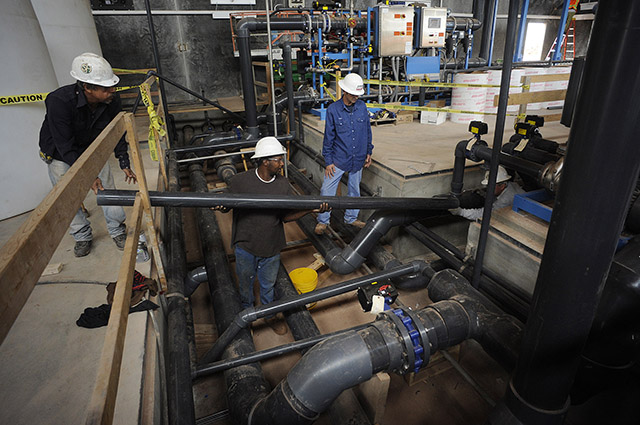Texas Towns Contemplate Drinking Recycled Wastewater

Construction workers install piping last month at the Big Spring Raw Water Production Facility, which purifies wastewater and mixes it with reservoir water for delivery to customers. Photo by Mark Sterkel/Odessa American.
By Kathleen Leon
For Reporting Texas and The Dallas Morning News
The West Texas towns of Brownwood and Big Spring are facing what may seem an unappetizing choice – reclaim toilet water for human consumption, or risk going thirsty.
Beset by chronic drought and depleted reservoirs, officials in both say new treatment plants will use state-of-the-art technology to filter wastewater into its potable cousin. Experts see it as a potential roadmap for many more cities in the state.
“We have no other viable options,” said David Harris, director of utilities for Brownwood. “Our current plant has plenty of treatment capacity, but if you don’t have any water to treat, it doesn’t matter.”
Brownwood and Big Spring won’t run out of water anytime soon, but both are using up existing resources at an accelerating clip. Both re-use projects are designed to augment natural sources by combining them with recycled wastewater.
The process, called direct potable re-use, has been used in the developing world but not in the U.S. The Big Spring plant is expected to be complete early next year, while Brownwood officials hope to begin work on theirs in 2013.
Not everyone likes the idea of drinking water that has been on a strange, toxic journey. What Brownwood resident Christopher Stephens calls the “yuck” factor helped raise a public outcry in San Diego in the late 1990s that stopped a similar reuse facility.
Stephens, a physician, says the city’s efforts to conserve water from Lake Brownwood, which started in 2011, should have come years earlier.
“Conservation and water-use planning seem to me to be the first and most practical response to Brownwood’s water problems, not the use of expensive new technology,” Stephens said.
But concerns over future water shortages may be trumping qualms about where the water comes from if recent developments are a guide. In 2011, San Angelo made news when it embarked on a $125 million project to pipe in radioactive water from the radium-laced Hickory Aquifer 65 miles away.
To allay public misgivings, officials in Brownwood and Big Spring point to plans for multiple backup systems and strict testing regimens. State officials say the recycled water will be tested to meet federal and state standards before residents are allowed to drink it or wash in it.
Lake Brownwood dipped to its lowest point last year since its creation in 1932. Harris said the city’s proposed recycling plant would eventually cut dependence on lake waters by 30 percent.
Were the plant operating today, he said, residents and businesses could forego stringent curbs on outdoor watering and other uses, and even then the city would use less water from the lake than in previous years. In the past 12 months, Stage 3 water restrictions have cut the city’s annual water consumption by 24.6 percent.
The city’s reuse plans “will protect the way of life we are accustomed to while utilizing existing … resources to solve our problem and help other communities by reserving some of the water we would have used from them,” Harris said.
The two cities will be the first in the U.S. to re-use such a direct form of wastewater. Both plan to employ reverse osmosis, a membrane-technology filtration process also used to clean brackish groundwater.
The primary difference is that the Big Spring project will merge treated wastewater with untreated, piped water from the city’s reservoirs, while Brownwood will combine its wastewater with treated surface water before the mixture enters the drinking-water system.
State officials say they recognize the possible downsides. “If the treatment system fails, there’s the risk of untreated water getting into the drinking water supply,” said Robert Mace, deputy executive administrator for the Texas Water Development Board.